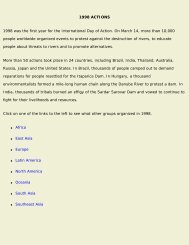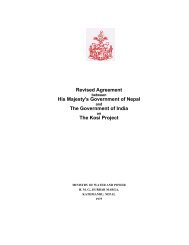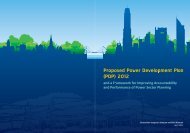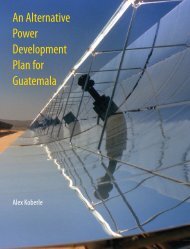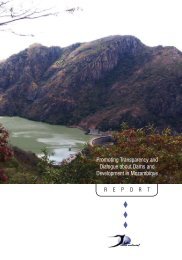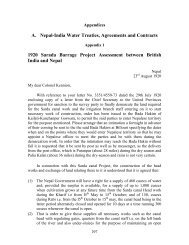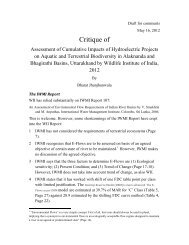Mountains of Concrete - International Rivers
Mountains of Concrete - International Rivers
Mountains of Concrete - International Rivers
Create successful ePaper yourself
Turn your PDF publications into a flip-book with our unique Google optimized e-Paper software.
Alternative ApproachesOne <strong>of</strong> the most important contributions <strong>of</strong> civil society has been in evolving alternative visions and approachesto meet the needs <strong>of</strong> water, energy, livelihoods and revenue. Several elements <strong>of</strong> such approaches have alreadybeen put forward by various groups. Some <strong>of</strong> these suggestions minimize the need to build large hydro and thermalprojects, while some claim that they can be totally eliminated. Combinations <strong>of</strong> demand-side management, efficiencyin generation, supply, transmission and energy use, and renewable sources <strong>of</strong> energy are at the core <strong>of</strong> most <strong>of</strong> thesesuggestions.Simply reducing transmission and distribution (T&D)losses can provide significant additional electricity. The “11 thPlan Document” for India states that “T&D losses in Indiacontinue to be among the highest in the world and are themain concern in the development <strong>of</strong> power sector…T&Dlosses for the country as a whole are estimated to be in therange <strong>of</strong> 35%–45%.” 145The <strong>International</strong> Energy Agency’s “Statistics forPakistan for 2005” show that distribution losses were 25%. 146The World Bank says that in Pakistan “the transmission anddistribution networks are over-loaded, underinvested, andunder-maintained, with technical and commercial lossessignificantly above the norm. Reducing losses from suchlevels are generally more cost-effective measures for reducingthe demand-supply imbalances than adding generationcapacity.” 147Prayas Energy Group, based in Pune, India, calls for anew paradigm <strong>of</strong> power and energy planning that demands“an integrated view towards planning for all inputs that arenecessary for livelihood security – water, land, energy andbiomass.” They call for an integrated least-cost plan to becarried out in a participatory manner, expanding the choices<strong>of</strong> technologies and fuels, and implementing supply-sideefficiencies and demand-side measures. 148Several analysts also point out that one cannot talkabout alternative approaches until one looks at demand.Supply cannot be increased indefinitely and no system canplan to meet unlimited demands.Some <strong>of</strong> the most important ideas and contributions tothis discussion are the many elements <strong>of</strong> alternative approachesemerging from popular struggles <strong>of</strong> affected people againstbig dam projects. One activist involved in supporting suchmovements has noted: “I believe that resistance movementsresult in alternate visions and development policy since thestruggling peoples’ vision becomes the focal point. Everyresistance movement and community struggle has its ownoptions and visions; they exist; only the policy makers areblind to them.” 149One <strong>of</strong> the most fascinating examples <strong>of</strong> alternativesemerging from people’s struggles around dams is that <strong>of</strong>Sulgaon Village in the submergence area <strong>of</strong> the 400 MWMaheshwar hydropower project on the Narmada Riverin India. The people <strong>of</strong> this village have been stronglyopposing the project as a part <strong>of</strong> the Narmada BachaoAndolan (NBA – Save the Narmada Movement). Guidedby experts from the Prayas Energy Group, Sulgoan citizenscarried out a comprehensive survey <strong>of</strong> energy consumptionand energy sources in their own village. Based on this, theydemonstrated that using demand-side measures to conserveenergy, along with local energy sources, mostly renewablebiomass, to generate electricity, they could not only meettheir own energy and electricity needs, but could also exportsignificant amounts <strong>of</strong> it. 150 Scaling this up could lead to alarge source <strong>of</strong> sustainable and renewable energy withoutmany <strong>of</strong> the serious social and environmental disruptionsthat come from other projects.There is a need to strengthen efforts to evolve suchvisions, plans and approaches for the entire region andwithin each country.Meeting to discuss the potential impacts <strong>of</strong> the planned West SetiHydropower Project, in Nepal, 2007. It is estimated that 15,000people will be adversely affected by this project. Photo: YukiTanabe.M o u n ta i n s o f C o n c r e t e : D a m B u i l d i n g i n t h e H i m a l aya s | 3 9




